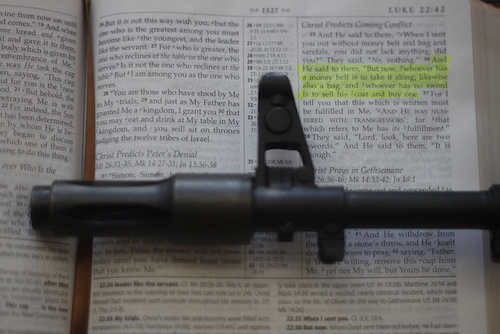We run our website the way we wished the whole internet worked: we provide high quality original content with no ads. We are funded solely by your direct support. Please consider supporting this project.

Did Jesus Instruct Us to Arm Ourselves?
Over the past few posts, I’ve been dealing with the passages that are frequently used to argue how Jesus condoned violence. One of these takes place just after the last supper and just before Jesus and his disciples were going to travel to the Mount of Olives to pray. To prepare his disciples, Jesus tells them; “if you don’t have a sword, sell your cloak and buy one” (Lk 22:36). According to some scholars, this instruction indicates that Jesus did not uniformly rule out his disciples resorting to violence in response to aggression. When read in context, I think it becomes clear that this instruction implies nothing of the sort.
First, this interpretation of Jesus’ instruction contradicts Jesus’ unqualified teachings about loving and serving enemies and about refraining from violence (e.g. Lk 6:27-36). On the assumption that Jesus would not blatantly contradict himself, we should start with the assumption that Jesus did not intend his disciples to use the swords he instructed them to buy.
Second, when the Temple Guard came to arrest Jesus, we must note how Jesus responded when his disciples asked him, “Lord, should we strike with our swords?” (Lk 22:49) – the very swords Jesus had just instructed them to purchase. Before Jesus had a chance to answer, one of his disciples “struck the servant of the high priest, cutting off his right ear” (v. 50). Jesus then said, “No more of this!” (v. 51), clearly indicating that he never intended for his disciples to rely on the swords they brought. This becomes even clearer in Matthew’s Gospel when Jesus rebukes this disciple by reminding him of the cyclical nature of violence. “Put your sword back in its place,” Jesus said, “for all who draw the sword will die by the sword” (Mt 26:52). And having rebuked this disciples’ typical worldly response to aggression, Jesus then modeled the way he would have disciples respond to aggression by healing this guard’s ear (Lk 22:51). Disciples are to serve, bless and pray for enemies, not afflict them.
The reason for Jesus’ instruction to buy swords in Luke becomes clear if we simply attend to the verse that follows it, for Jesus explains his instruction by quoting Isa 53:12: “And he was numbered with the transgressors.” Jesus then adds: “and I tell you that this must be fulfilled in me. Yes, what is written about me is reaching its fulfillment” (v. 37). It is apparent that the purpose for having some of his disciples carry swords was not so they could defend him, but simply to fulfill this prophecy, thereby justifying his opponents arrest of him as a political revolutionary. This also explains why Jesus said “[t]hat’s enough” after his disciples told him they had two swords among them prior to heading to the Mount of Olives (Lk 22:38). Had Jesus expected them to actually fight the Temple guard, a mere two swords would not have sufficed. But two were sufficient to make Jesus appear as, and ultimately to be crucified as, a political transgressor.
Finally, it is significant that when Jesus later appeared before Pilate and was asked if he was the King of the Jews, Jesus responded that his kingdom was not of this world, and he pointed to the fact that his followers were not fighting as proof of this fact (Jn. 18:36). Were Jesus the king of any earthly kingdom, his followers would have certainly taken up arms to defend him. This is how all earthly kingdoms operate. The fact that Jesus’ followers were not fighting thus constitutes the definitive proof that the kingdom Jesus ushered in was of a very different sort. And this simply confirms the point that Jesus never intended his disciples to use the swords he instructed them to purchase.
Photo credit: jonmallard via VisualHunt.com / CC BY-NC-SA
Category: General
Tags: Jesus, Kingdom Living, Non-Violence
Topics: Enemy-Loving Non-Violence
Verse: Luke 22
Related Reading

Was Jesus Fully Human and Fully God?
The New Testament is very clear that Jesus was a full human being. He had to grow in wisdom (Lk 2:52) and learn obedience by going through trials, just like every other human being (Heb. 5:8). He grew hungry and tired, like the rest of us. He experienced the same range of emotions as the…

The Warfare We Have Inherited
Image by Chris Sardegna Jesus’ miracles over nature, as well as his healings, exorcisms and especially his resurrection, were definite acts of war that accomplished and demonstrated his victory over Satan. These acts routed demonic forces and thereby established the kingdom of God in people’s lives and in nature. But their primary significance was eschatological. People…

When the Last Few Moments Changes Everything
One of the central things ReKnew wants to accomplish is to challenge followers of Jesus to accept that the self-sacrificial love Jesus revealed on the cross is the definitive, and even the exhaustive, revelation of God’s character. Everything about God, we believe, should be understood through the lens of the cross. For most Christians, Jesus…

How to Overcome the Flesh Mindset
Unless you have taken intentional steps to change, the way you presently experience yourself and the world around you was mostly chosen for you, not by you. Think about that. You inherited a way of interpreting the world. Your brain has been in the process of becoming programmed by factors outside your control from the…

Jesus and Democracy
Question: I’ve heard that the reason Jesus didn’t speak up on political issues was because he didn’t have the benefit of living in a democracy. Since we do, don’t we have a duty both to God and our country to be involved in politics? Answer: If the reason Jesus didn’t speak up on political issues…

The Wrong “Bulls-Eye”: Reflections on the “Christian Left”
As it has since the fourth century, the Church today for the most part operates with a Constantinian (“power-over”) paradigm. Because of this, most socially concerned Christians are inclined to define the Church’s mission as adjudicating between and tweaking political options “in Jesus’ name.” We accept Caesar’s definition of “power” as the ability to get…
